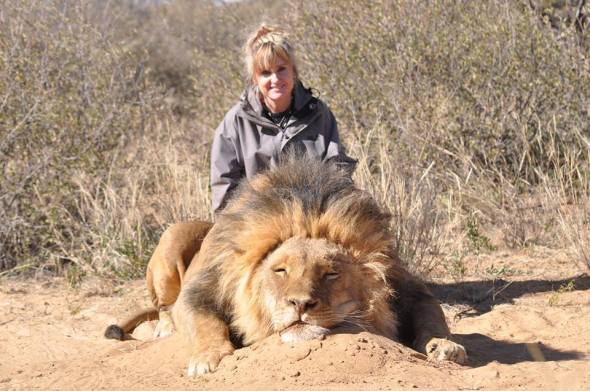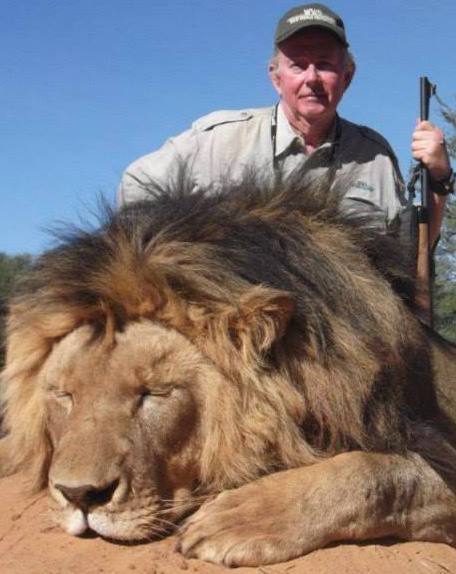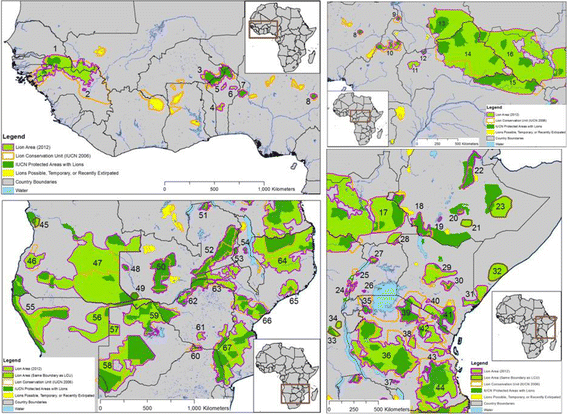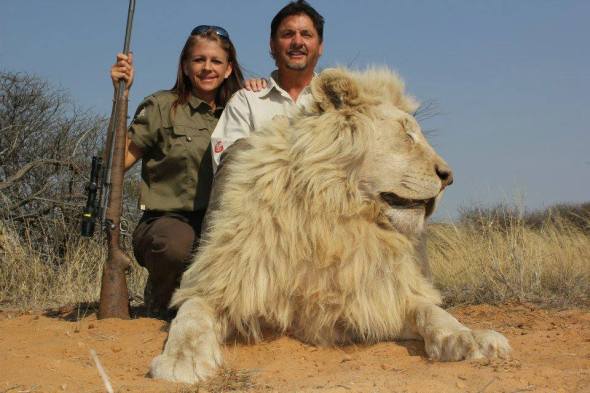Lion Hunting - The BIG Debate.
Lion populations are diminishing and still hunting organisations are taking no responsibility for such vast decreasing trends that have pushed many conservation organisations to now take direct action into preserving the last of the Panthera species.
The west African Lion is virtually extinct with only a mere thirty five left roaming the wild grasses and savanna’s. Will we see them pushed into extinction by the middle of next year. Regrettably more than likely.
Lion populations have decreased in the last century from a staggering 400,000 individuals to only 40,000 left within the African wild. Demand for hunting trophies, such as Lion skin rugs, and a thriving trade in animal parts in the US and across the globe have raised the threat levels for African Lions, which are already under assault because of conflicts with local villagers and shrinking habitat. Hunters deny this though still quoting and documenting outdated facts and information to confuse many Animal Rights Activists and general concerned public gauged from their subscription to hunting units - they actually believe the woven propaganda that hunting big guns preach - of course we know why such preaching is big on the agenda - money and lots of it.
The king of the jungle is heading toward extinction, and yet Americans continue to kill Lions for sport. Americans being the largest players in this game that have swamped my African land by the bloody plane loads just to slaughter, very little conserving. Canned hunting or wild hunting if its a Lion the American hunting citizen will net it at any cost. Detailing their nauseating “sport” online and within hunting porn magazines.

Picture above - Adele Jansen van Rensberg - Lion and big game hunter.
Adele Jansen van Rensberg’s hunting fiend (one of many) quoted the following to our main environmental unit
“I totally support you, Adele van Rensberg, and congratulate you on this beautiful male lion. It’s such a shame that the haters don’t take the trouble to learn the facts, and merely allow themselves to be controlled by their ill-informed emotions. They select what they want to believe and refuse to listen to the truth … which is that it is only thanks to the animal management that is paid for by hunting, that any of these animals survive in the wild. Were it not for the millions of dollars poured into conservation by hunting, these animals would be extinct through illegal poaching and removal for human safety reasons. Hunting pays for fences to protect cattle, for relocation to protect humans, for wardens and rangers to fight poaching, for equipment and staffing, and for special reserves for breeding and reintroduction. So, no matter how ironical the antis may think this picture, we know that for every one [old, nuisance or condemned] lion that is legally shot, multiple lions are saved. Well done, lady, keep up the good work
The number of wild African Lions has fallen sharply in the last 100 years. A century ago, as many as 200,000 roamed across Africa. Now, by some estimates, fewer than 40,000 remain in the wild; other organisations put the figure for survivors at 23,000, and they have vanished from 80% of the areas where they once roamed. Lions have become extinct in 26 countries. Only seven countries – Botswana, Ethiopia, Kenya, South Africa, Tanzania, Zambia and Zimbabwe – are believed to contain more than 1,000 Lions each. One thousand Lions in each habituating nation (not exactly over populated is it?) and when one views hunters both men and women - even children taking such large quotas it worries myself more now than it did today when another thousand suddenly disappear.
The single biggest threat by far to the animals’ survival is humans, though not necessarily western hunters. It is just the very, very widespread killing of Lions, mostly in a conflict situation, by anyone who is trying to farm livestock in Africa and finds it very difficult to co-exist with Lions. There is also a lot of pressure on lion habitats with wilderness areas shrinking to build roads – such as the controversial highway across the Serengeti – or to make room for agriculture.
But the report by the wildlife coalition, filed with the White House said western hunters were a growing danger to the Lions’ survival. Between 1999 and 2008, 64% of the 5,663 Lions that were killed in the African wild for sport ended up being shipped to America, it said. It also said the numbers had risen sharply in those 10 years, with more than twice as many Lions taken as trophies by US hunters in 2008 than in 1999. In addition to personal trophies, Americans are also the world’s biggest buyers of lion carcasses and body parts, including claws, skulls, bones and penises. In the same years, the US imported 63% of the 2,715 Lion specimens put up for sale. American hunters are fueling the trade in pseudo Tiger bone wine too - selling Lion bones and carcasses to Asia to produce fake Tiger bone wine thus continuing the trade in endangered species, and illegal poaching of Lions and Tigers, for the want of more.
For some countries, including Tanzania, Zambia, Namibia and Mozambique, hunting for sport was the main threat to the Lions’ existence. But even in countries which did not attract large numbers of tourists on hunting trips, the practice was taking a growing toll. Conservationists noted that hunters’ penchant for bagging a male lion risked wiping out entire prides. The loss of the alpha male could set off a struggle for supremacy among the survivors that could lead to further deaths of adult male Lions, or male cubs seen as potential threats.
International Animal Rescue Foundation Africa and other conservationists are calling time now on this trade and want a hunting moratorium implemented sooner rather than later that would reduce that threat by taking Americans out of the game. It’s one of a range of threats to the survival of the species. But what is most certainly true is that of all the threats to the African lion, the one we can best address here in this country is their import.”
It was noted that all of the other big cats are protected – Jaguars, Leopards and Tigers. African Lions are the only ones left out there. However, other wildlife experts argued that a total hunting ban was a “nuclear option”. They said responsible hunting could in some cases help conserve populations by maintaining wilderness areas. Existing US and international regulations, such as the Cites conventions against trafficking in endangered species, could also be reinforced to protect Lions, they said. If you remove hunting, the very real risk is that you force African governments to generate revenue from that land and the obvious thing is cattle and crops which just wipe out habitats said one Hunter. We cannot just sit back though and do nothing. We have to try and preserve our species and if we fail we try and retry again.
We define African savannahs as being those areas that receive between 300 and 1,500 mm of rain annually. This broad definition encompasses a variety of habitats. Thus defined, savannahs comprise 13.5 million km2 and encompass most of the present range of the African Lion (Panthera leo). Dense human populations and extensive conversion of land to human use preclude use by Lions. Using high-resolution satellite imagery and human population density data we define lion areas, places that likely have resident Lion populations. In 1960, 11.9 million km2 of these savannahs had fewer than 25 people per km2. The comparable area shrank to 9.7 million km2 by 2000.
Areas of savannah Africa with few people have shrunk considerably in the last 50 years and human population projections suggest they will likely shrink significantly in the next 40. The current extent of free-ranging Lion populations is 3.4 million km2 or about 25 % of savannah area. Habitats across this area are fragmented; all available data indicate that between 32,000 and 35,000 free-ranging Lions live in 67 Lion areas. Although these numbers are similar to previous estimates, they are geographically more comprehensive. There is abundant evidence of widespread declines and local extinctions. Under the criteria we outline, ten Lion areas qualify as lion strongholds: four in East Africa and six in Southern Africa. Approximately 24,000 Lions are in strongholds, with an additional 4,000 in potential ones. However, over 6,000 Lions are in populations of doubtful long-term viability. Lion populations in West and Central Africa are acutely threatened with many recent, local extinctions even in nominally protected areas.
In Africa, Lion populations once lived outside this strict savannah zone. For example, until recently a Lion population was present in forest-savannah mosaics in Gabon and the Republic of Congo (“Congo-Brazzaville”) (Henschel 2009), and there are other remnant populations in forests in Ethiopia and other non-savannah environments. However, the association between Lions and savannahs is generally now quite a close one. How much of the African savannah still supports Lions—and is likely to do so in the future—are the more difficult questions we are addressing.
We evaluate the state of the African savannah with two objectives, namely estimating the areas of savannah still suitable for Lion populations and estimating the Lion populations themselves within these areas. If areas retain Lions, the continent’s top predator, they are likely to be reasonably intact ecosystems. By considering the size of savannah Africa from the Lion’s perspective, we can assess how much of it remains in large, relatively intact areas, not yet heavily modified by human influence. Clearly, smaller areas will still support less complete sets of species.
Current Lion populations based on many assessments are as follows for the continent of Mama Africa;
The assessments are based on Chardonnet, Bauer and Van Der Merwe, IUCN, and present review and source reports
- West - Chardonnet - 1,213 - Bauer and Van Der Merwe -701 - IUCN - 1,640 - Present -480
- Central - Chardonnet - 2,765 - Bauer and Van Der Merwe - 860 - IUCN - 2,410 - Present - 2,419
- East - Chardonnet - 20,485 - Bauer and Van Der Merwe - 11,167 - IUCN - 17,290 - Present - 19,972
- South - Chardonnet - 13,482 - Bauer and Van Der Merwe - 9,415 - IUCN - 11,820 - Present - 12,036
Total
- Chardonnet = 37,945
- Bauer and Van Der Merwe = 22,143
- IUCN = 33,160
- Present = 34,970
- Present review but no SCI or IGF funded reports = 32,260
The Biodiversity and Conservation Report in brief estimate the following Lion populations as shown below;
Lion bones are a sought-after ingredient used to make lion bone wine, a substitute for the traditional Asian cure-all,tiger bone wine, which fetches up to R250 000 a case at illicit auctions.
Conservationists have warned that captive breeding and canned hunting programmes in South Africa are providing a source for the lion bone trade. Canned lion hunting is legal in South Africa, as is the exporting of lion carcasses. Lion populations across Africa have been reduced by 90% over the past 50 years, but lion breeders say their operations have nothing to do with the continent’s wild populations.

Typically Hon Edna Molewa didn’t respond to any of the information listed hereto - but then does she ever respond to issues such as Rhino conservation? No- she sides with hunters and pro-trade lobbyists instead.
Breeders can benefit financially a number of times from the same lion. Cubs are often rented as tourist attractions and visitors pay to pet and interact with them. The fee paid by visitors is then fed back into captive breeding programmes. As adults, the lions are sold to hunters in canned hunting arrangements.
Farmers and hunting operators charge in the region of about $20 000 (R160 000) as a “trophy price” and hunters can expect to pay around $18 000 (R145 000) for other services, excluding taxidermy. But the hunters are only interested in the head and skin of the lion, and often leave the bones with the breeder, who can then sell the bones, with a government permit, to Asian buyers for use in making lion bone wine.
It’s estimated that a complete lion skeleton can sell for as much as R80 000. Last year it emerged that over 1 400 lion and leopard trophies were exported from the country in 2009 and 2010. According to the environmental affairs minister, in 2010, 153 live lions were exported as well as 46 lion skins, 235 carcasses, 592 trophies, 43 bodies and 41 skulls. It was noted that these figures were incomplete as the provinces had not yet captured all their data. Yet there was a 150% growth in exports of lion products from 2009 and 2010.
Amplifying an illegal industry
Chris Mercer, director of the Campaign Against Canned Hunting, said hunting captive-bred lions was “hideously damaging” to conservation. “It’s farming with alternative livestock. They’re only doing it because they make more money farming lions than they do sheep or cattle. But they don’t realise they’re harming the wild populations by creating and amplifying an illegal industry and allowing it to prosper,” he said.
Mercer said he believes the export of lion bones and in fact the entire canned hunting industry should be banned. He pointed out that there was a huge overlap between the rhino horn and lion bone trade. “Many of the Asiatic groups dealing with lion bones are the same people dealing with rhino horn,” he said. He criticised government for taking a simplistic view of the matter and overlooking the dangers the lion bone trade poses. “The very people who are doing our rhino horn [poaching] are making money out of this. You can just imagine how the illegal trade is going to piggy-back itself onto this legal trade,” he warned.
Banning the entire trade will be difficult. There are almost 200 lion breeders in the country, many of whom are part of the powerful Predator Breeders’ lobby group. The breeding of lions for trophy hunting is a lucrative business. In 2009, the economic value of trophy hunting was estimated to be between R153-million and R832-million.
Rapidly going extinct
But Pieter Kat, director of the UK-based conservation organisation LionAid, said a lot could be achieved simply by placing a ban on the export of lion bones. Lions are listed on appendix two of the Convention on International Trade in Endangered Species of Wild Fauna and Flora, which means that a government permit is needed to export any lion products. “It will take a position of responsibility by South Africa to say, ‘No more, we will not allow this,'” he said.
“South Africa is within its rights [to] say no more export permits,” said Kat.
Kat said that while one could argue about the ethics of breeding lions just to be shot, it was important to bear in mind that whatever South Africa did in terms of its legal trade in lion bones would affect wild lion populations all over the continent. Kat pointed out that there are only about 20 000 lions left on the entire continent – down from about 200 000 in the 1970s. In the past few years Côte d’Ivoire, Ghana and the Republic of Congo-Brazzaville have lost all their lions, while countries like Nigeria, Malawi and Senegal have only a few dozen lions left.
“We’re dealing with a species that is rapidly going extinct but because we are not really focused on lions – we’re talking about elephants and rhinos – it’s a silent extinction,” he said. He warned that allowing the trade in lion bones to proliferate would stimulate a demand for the product. “Soon someone will [realise] it’s cheaper for to poach than to pay the owner of a captive animal to get the bones,” he said.
Breeding for exploitation is only human
But Professor Pieter Potgieter, chairperson of the South African Predator Breeders’ Association, defended the industry saying there is little difference between breeding lions and any other mammal. “Chickens are killed by humans. How are lions different from them?” he asked. “In principle a lion is not more or less than a crocodile, an ostrich or a butterfly. It’s a form of life. Breeding animals for human exploitation is a natural human process,” he said.
Potgieter said that breeding and hunting lions was only deplorable in the eyes of the public because a “sympathetic myth has been created about the lion as the king of the animals”. He justified the practice, saying the export of lion bones is a legal trade authorised by the department of environmental affairs and denied that South Africa’s approach to captive breeding and canned lion hunting was feeding into the Asian demand for lion bones. “I don’t think that market is being created by the South African situation. That would happen anyhow and the more the Asian tiger gets extinct, the more people will try to get hold of lion bones as a substitute,” he said.
In 2007 former environmental affairs minister Marthinus van Schalkwyk attempted to put the brakes on canned lion hunting. It was widely reported that the activity had been banned in the country but this is not the case. Some changes to legislation were made but the Supreme Court of Appeal ruled in favour of the Predator Breeders’ Association and overturned an attempt to enforce a two-year waiting period during which a captive-bred lion would be allowed to roam freely in an extensive wildlife system before being hunted, which conservationists had labeled an attempt to “pretend that the lion is wild”.
Kenya alone loses approximately 100 of its 2,000 wild lions every year due to killing by people. At this rate, lion experts believe there will be no more wild lions left in Kenya by the year 2030. Dramatic loss and fragmentation of habitat due to an ever-expanding agriculture frontier. This is confining lions to isolated islands of habitat, increasing their risk of extinction. Scarcity of wild prey due to overhunting by humans. When wild prey are over-hunted by people, lions are forced to feed on livestock, especially when cattle are poorly managed and not actively herded. This establishes a vicious cycle in which lions are forced to prey on livestock, driving further conflict with humans in which the lion ultimately loses.
All information is up to date on going to press -
Lion hunting the BIG DEBATE - Part I of IIII
Speak Up For The Voiceless.Org publishes controversial topics and investigations on animal and environmental abuse and welfare. All data is is for educational - awareness and activism from which we do not under any circumstances promote or encourage violence or misconduct against anyone or individual organisation - company based on our reports and that of third parties. We are not/will not be held responsible for anti-social behavior or aggression towards others vie written articles. Speak Up For the Voiceless.Org will not remove any article based on any EU or Non-EU law - Speak Up For The Voiceless.Org are based in Iceland, Namibia and London. We do exactly what it says on the tin - Animal and Eco Environmental and Animal abuse - Welfare Investigations Unit.
PLEASE SIGN AND SHARE Sign - http://www.avaaz.org/en/1_million_to_ban_the_lion_trade_fbb/?fbb
PLEASE SHARE THIS ARTICLE TO CREATE AWARENESS AND FIGHT BACK.
Stay tuned for part II you’ll not want to miss it.





South Africa should institute a stricter law for tourism, if people come into the country they should be interrogated and their reason for the visit documented..if they kill any animals the fine should be in the millions or a jail sentence like it is for drugs in certain countries. I abhor and detest these foreigners coming to our country to kill our animals, I say ban them!
May 25, 2014 at 8:57 am